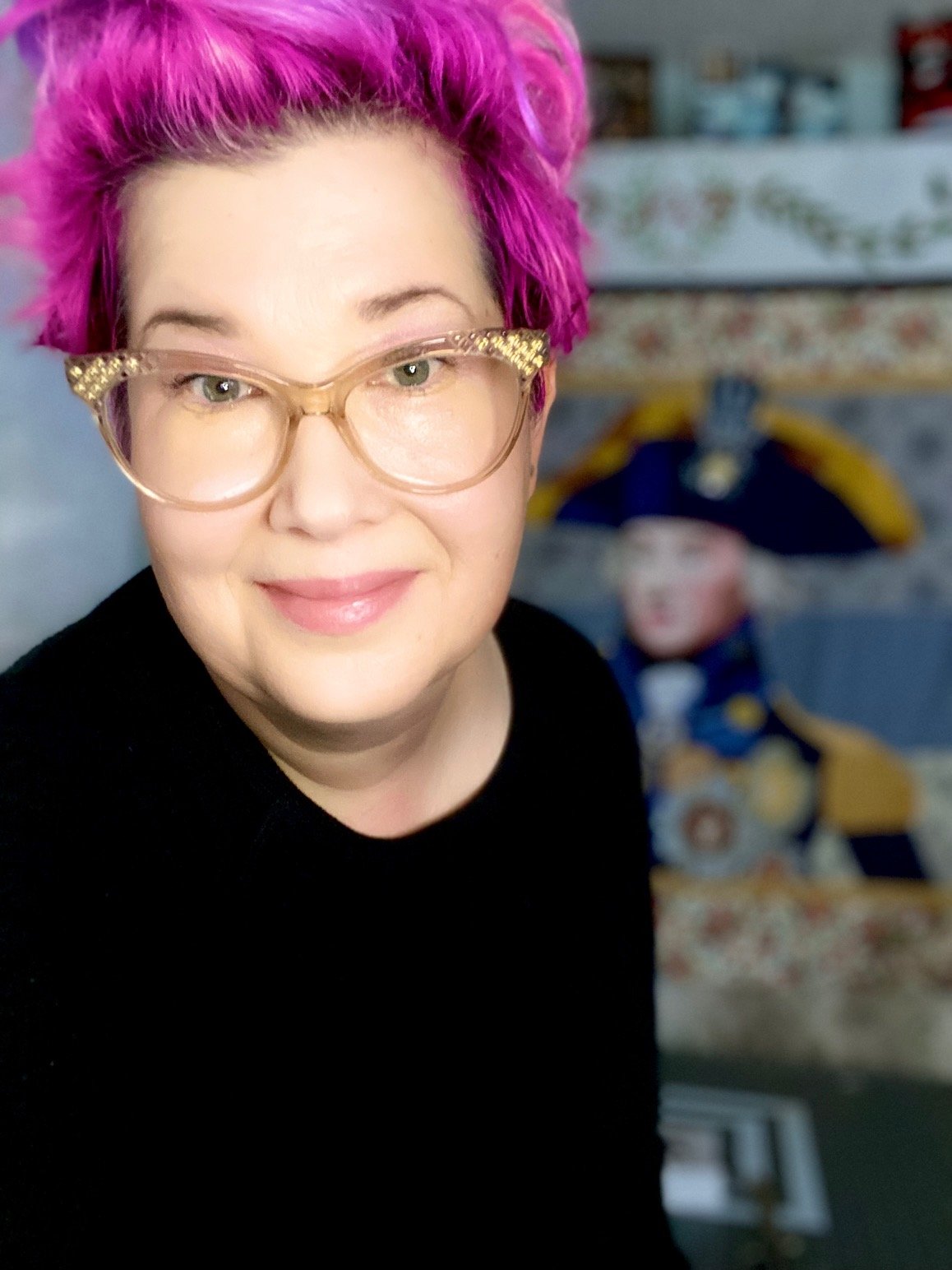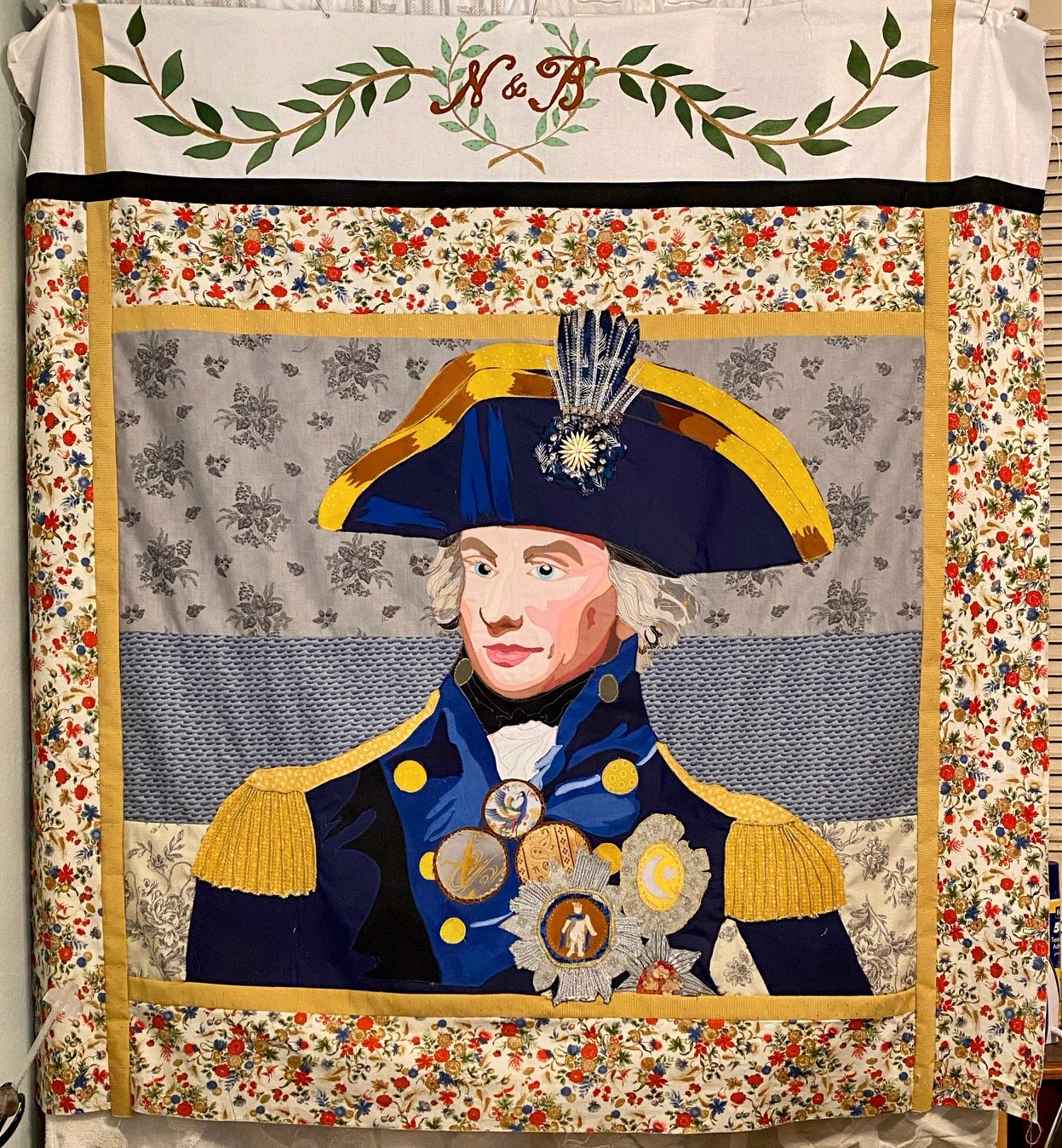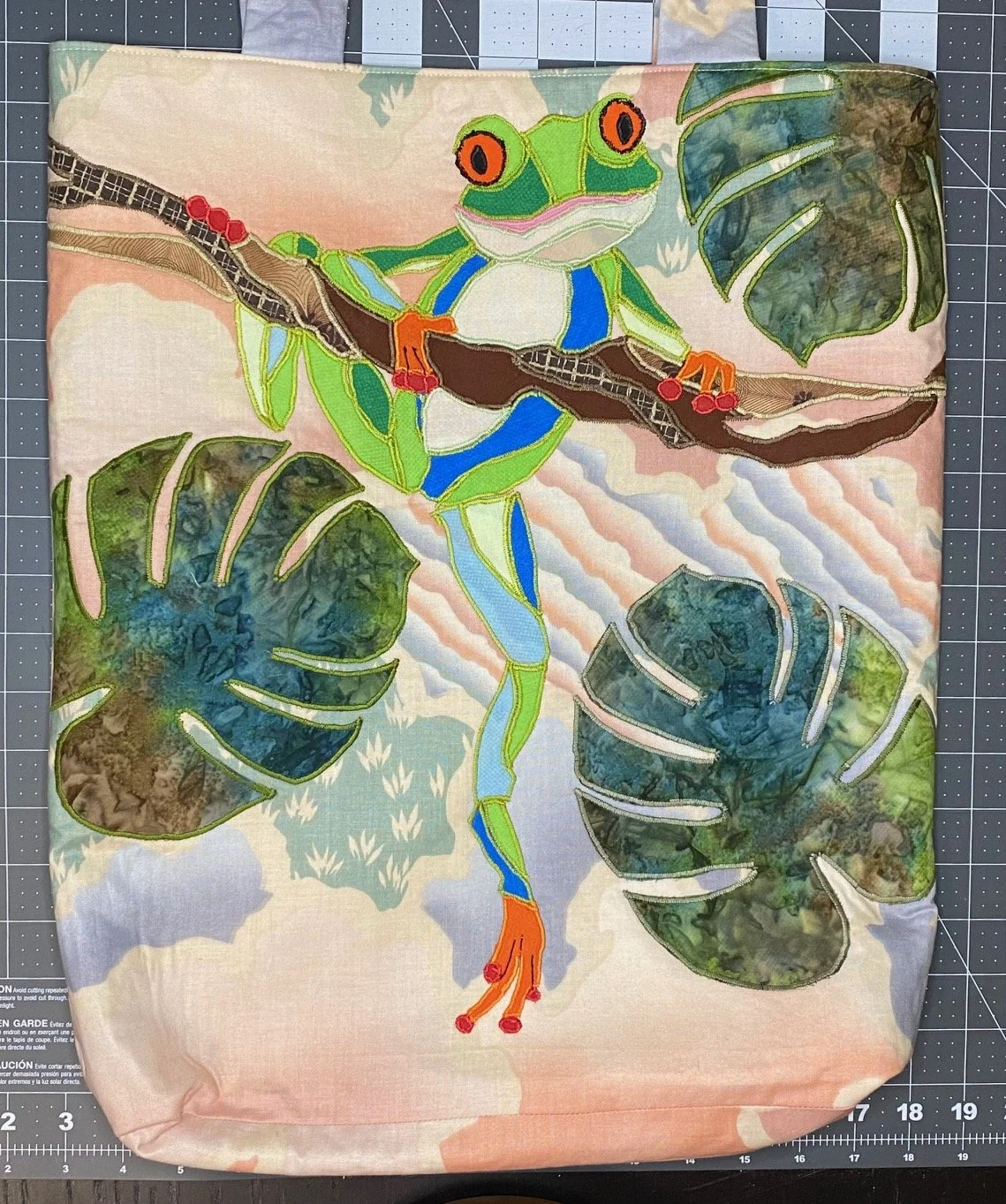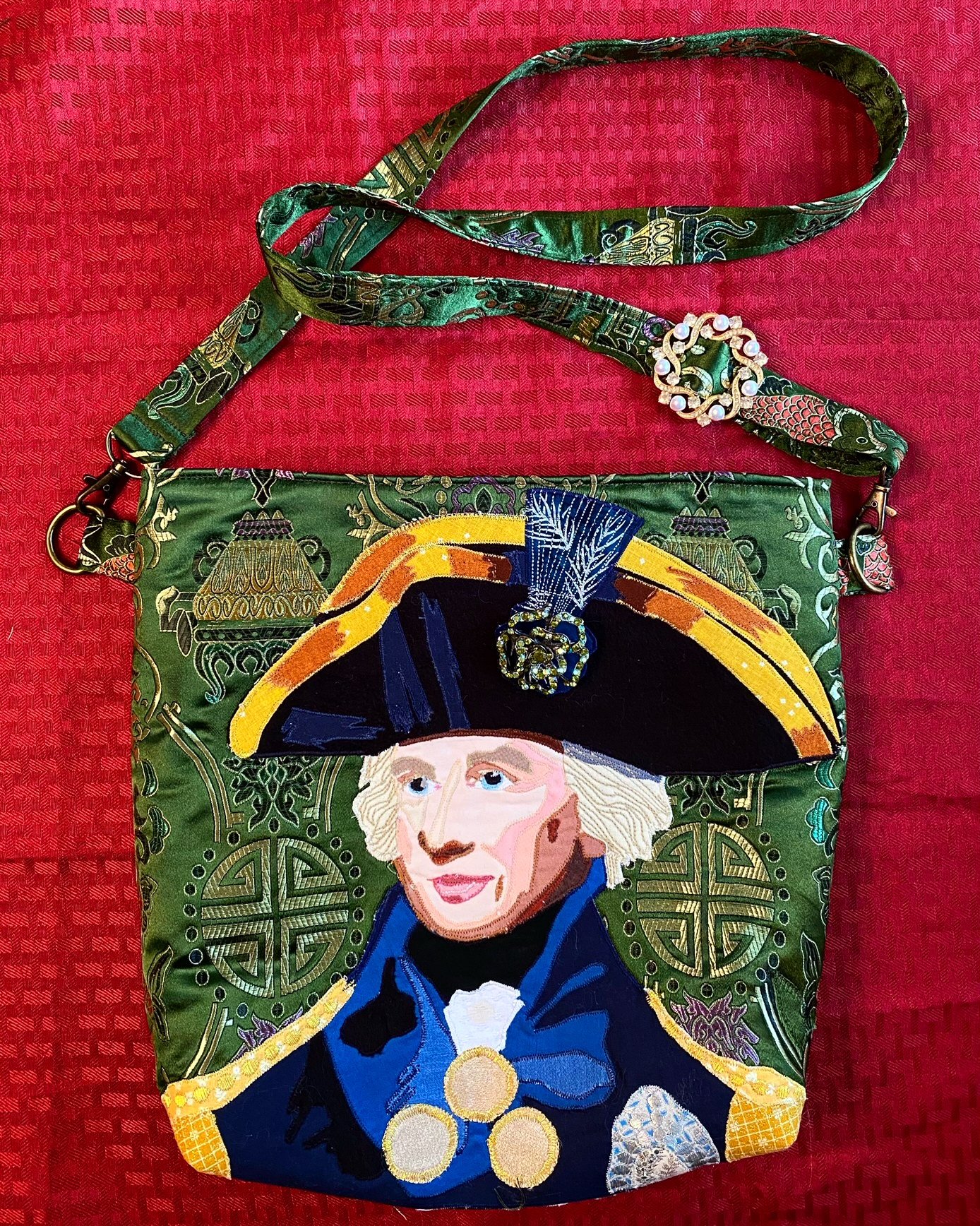Artist Spotlight: Natalie Durkin
Each month, we highlight one of the extraordinary artists in our reuse community. This month, it’s textile artist, Natalie Durkin (she/her)!
Learn about Natalie’s evolutionary journey into textiles, and how one art teacher’s rule changed the way she makes things to this day. Then, grab a glimpse of some of her amazing creations!
1. When did you start making textile art?
I have been an artist in some form or other my entire life, including obtaining a BFA in art history and painting from The University of Texas here in Austin. However my evolution into textiles came as a byproduct of the pandemic. My grandmother was an expert seamstress, and though she never taught me, I did inherit much of her supply and equipment stash and used her legacy as a springboard to teach myself. As the pandemic hit us all back in early 2020, I, like many others, gave myself a crash course in mask making, often utilizing whatever I could find around the house to use for materials, but also buying fabric to make some cute ones. I ended up with an enormous quantity of scraps that felt completely wrong to toss, but I didn’t know what to do with, so I began to think about making a quilt from them. I had zero interest in quilting up to that point, and even less inclination, but I have long been a fan of collage. I began to think that making myself a quilt from the mask scraps I had accumulated, while thinking of it as a fabric “collage" would be a meaningful way to commemorate that time in my life. Using the mask scraps could be a reminder of my contribution to try to help keep one another safe while also finding a way to use the scraps beyond their initial purpose. I made that quilt and several others, and learned that I love the designing, the cutting and the piecing, but found no real joy in the “quilting” part of quilting. From there I began to make projects as gifts for friends and families, be they quilts, tote bags, purses, and the like. Then, a year ago, I had super random brain flash- to make a fabric portrait. I was never super into figurative art, never done appliqué, and had no idea how to go about it, but That Voice told me to push through. My first opus was a wall-sized appliqué portrait of British Vice Admiral Horatio Nelson (still a WIP) and I loved the process! It was by accident that I was asked if I could put a fabric portrait onto a tote bag- Queen Elizabeth to be specific. One “Queen Bag” became requests for 3 more, and the rest is history. I have a rather unconventional niche of putting fabric collage portraits on bags, but I am by no means only limiting myself to that format. Bag, purse, wall hanging, something else... I’m game.
2. Which aspect of creating is your favorite?
Back in middle school, we had an art teacher who refused to let students have more than one sheet/piece of material per project. Be it painting, lettering, crewel embroidery, whatever. One. The end. We hated it. We usually “messed up” and wanted to start over with a new one. Her answer was always the same. She told us “You have the front. You have the back. After that you must problem solve.” We LOATHED this rule. But here I am 4 decades later finding that “problem solve” is one of the things I am most passionate about creatively. I find inspiration and excitement in making a project work using what I have or can find vs sourcing exactly what I need new from a retail store. I love the creative head space I achieve when I think about a project and what it needs, and how I can accomplish those needs with out of the ordinary materials, colors, prints, or notions. I have discovered incredible combinations and design opportunities by embracing the Problem Solve method of design and execution. It is my favorite part of reuse as source material and media.
3. Where do you get your inspiration?
I get inspiration from all kinds of things- Having a background in art history, obviously historical figures are fun for me. Specifically, if I can find a way to bridge the gap from “history” to “today” by turning something on its head, by interpreting it in a contemporary way, or highlighting an attribute or idea in such a way that connects our experiences in the past to our present, I get excited. Other ways I find inspiration come from seemingly random ideas or instructions that pop into my head. “Make a larger than life fabric portrait of Horatio Nelson” is a perfect example of this. I had no experience in the subject or the medium, but there was the idea. I’ve learned to just go with it. Some of my favorite pieces and projects come through this way. I have learned not to question it or doubt it, but to just dive in and see what happens. Additionally, when people approach me for commissions, I draw inspiration from their ideas. At first I can feel insecure or nervous that I will miss the mark in terms of what they are hoping for, but if I can click into what excites them about their chosen subject, or why it’s special to them, I dial into that point of view and feel inspired to take their vision and create from there. These are additional versions of “Problem Solve.”
4. What is your preferred way to engage with your audience?
I love engaging with people about my work. My favorite way is to have people stop to talk to me about the bag I carry, or to hear stories about people who have commissioned or bought things from me telling me experiences they’ve had out and about while carrying my work “out in the wild." To see the absolute joy on people’s faces when they receive what they’ve asked me to create. It is hands down the best feeling in the world. Anything I can do to make art and the subjects I choose to create seem more accessible and conversational are what really make me tick. Once I get through my current production list of orders, I want to work on creating enough pieces to put on a show of my work. Balancing time and physical stamina are always on my learning curve, but the goal is to create enough to show while still accepting commissions. Also on my interactive wish list are to find ways to teach and share my process with others. I’d love to demystify how it all works so that others feel empowered to maybe give it or a variation of what I do, a try.
5. How does reuse play a part in your creativity?
Reuse is everything for me creatively! I have never been one to gravitate to a new/now/next type of lifestyle. The vast majority of my furniture and house fittings, plates, utensils etc. are older than I am or second hand. I have always found great enjoyment and contentment in trying to use what’s available and to limit the size of my consumption footprint in general. In my art, I use as much repurposed, upcycled, second hand, hand me down, or otherwise reused materials as possible. For my portrait tote bags, I do use some stabilizers and fusible adhesives and fleece type interfacings that I may buy new, but as far as fabric, threads, zippers, pencils, tapes, paper I use for templates, notebooks etc., if I can’t get it reused or repurposed, I’m not using it. In addition to making my art more sustainable, putting reuse at the forefront of my creative process has opened up a treasure trove of inspiration or design choices that never would have come through otherwise.
6. What compels you to donate to ACR?
Art and creative supplies are PRECIOUS. Being a lifelong maker and artist, I invariably end up with more stuff than I use. Or I have something that was part of my creative wheelhouse, but has fallen by the wayside to make room for something new (to me). To be able to donate quality supplies to ACR is not just a benefit to others, but it is such a gift for myself in that I know they are going to good use. That their value and use will be understood and appreciated. That they won’t end up in a landfill. That someone else will get to use what I did not. That someone who may have limited access to brand new art supplies, which can be prohibitively expensive, can obtain quality materials and supplies. I not only donate, but I am a customer for the same reason. I am currently in between careers- repeat joint injuries and reconstructive surgeries caused me to retire unexpectedly last year from 23+ years as a rehabilitative massage therapist, and consequently finally put me in the mindset to make a professional go of my art. My budget as a result is also tight, so I appreciate the donations of others, just as others can appreciate the donations I make. I also tip at the ACR register whenever I can.
7. Do you have a favorite ACR find?
How did you use it? A favorite ACR find. Gosh. So many great finds! 2 things come to mind- In my large Nelson portrait, I put sprigs of laurel leaves framing his initials at the top. The leaves look lush and gorgeous, and expensive, and they catch the light with the direction of the fabric pile. They look like an extraordinary velvet in a perfect shade of moss green. Truth be told, it was the most synthetic, 70s, olive green, nearly-destroyed-my-iron-on-the-lowest-setting, goodness-knows-what, how-will-I-EVER-use-this kind of material I got in an ACR mystery bundle one time. It is truly some gnarly decades old ick on first examination, but as those laurel leaves? Instant transformation into something sublime! I love taking the lowly and elevating it to the amazing. Another find was an amazing 2 yards of Toile de Jouy fabric that I turned into a pair of pyjamas for myself.
8. Where can we find out more about your work?
As mentioned, I recently retired from a previous career as a sports/rehabilitative massage therapist. As a result, my website is being retooled from that to my current (long overdue, reclaiming lifelong dream) career as an artist. It is however up and active, www.NatalieDurkin.com. I have an Instagram page devoted to my art where people can find and interact with me: @Natalie_Durkin_Textile_Arts. People can also email me with questions or commission enquiries at natalie@nataliedurkin.com.







